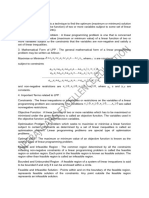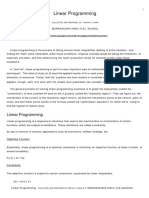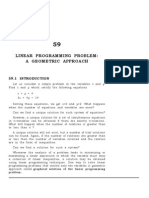Linear Programming: Short Notes 2
Uploaded by
ry416462Linear Programming: Short Notes 2
Uploaded by
ry416462CHAPTER
14 Linear Programming
A linear programming problem is one that is concerned Theorem 2: Let R be the feasible region for a linear programming
with finding the optimal value (maximum or minimum) problem, and let Z = ax + by be the objective function. If R is
of a linear function of several variables (called objective bounded, then the objective function Z has both a maximum and
function) subject to the conditions that the variables are a minimum value on R and each of these occurs at a corner point
non-negative and satisfy a set of linear inequalities (called (vertex) of R.
linear constraints). Variables are sometimes called decision If the feasible region is unbounded, then a maximum or a
variables and are non-negative. minimum may not exist. However, if it exists, it must occur
at a corner point of R.
A few important linear programming problems are:
Corner point method for solving a linear programming
(i) Diet problems problem. The method comprises of the following steps:
(ii) Manufacturing problems (i) Find the feasible region of the linear programming
(iii) Transportation problems problem and determine its corner points (vertices).
The common region determined by all the constraints (ii) Evaluate the objective function Z = ax + by at each
corner point. Let M and m respectively be the largest
including the non-negative constraints x ≥ 0, y ≥ 0 of a
and smallest values at these points.
linear programming problem is called the feasible region (or
(iii) If the feasible region is bounded, M and m respectively
solution region) for the problem.
are the maximum and minimum values of the objective
Points within and on the boundary of the feasible region function.
represent feasible solutions of the constraints. If the feasible region is unbounded, then
Any point outside the feasible region is an infeasible solution. (i) M is the maximum value of the objective function, if
Any point in the feasible region that gives the optimal value the open half plane determined by ax + by > M has no
(maximum or minimum) of the objective function is called point in common with the feasible region. Otherwise,
an optimal solution. the objective function has no maximum value.
The following Theorems are fundamental in solving linear (ii) m is the minimum value of the objective function, if
programming problems: the open half plane determined by ax + by < m has no
point in common with the feasible region. Otherwise,
Theorem 1: Let R be the feasible region (convex polygon) for a the objective function has no minimum value.
linear programming problem and let Z = ax + by be the objective
If two corner points of the feasible region are both optimal
function. When Z has an optimal value (maximum or minimum),
solutions of the same type, i.e., both produce the same
where the variables x and y are subject to constraints described by maximum or minimum, then any point on the line segment
linear inequalities, this optimal value must occur at a corner point joining these two points is also an optimal solution of the
(vertex) of the feasible region. same type.
You might also like
- Key Notes: Chapter-12 Linear ProgrammingNo ratings yetKey Notes: Chapter-12 Linear Programming2 pages
- 12_maths_key_notes_ch_12_linear_programmingNo ratings yet12_maths_key_notes_ch_12_linear_programming2 pages
- Linear Programming Chapter - 12 (Class XII)No ratings yetLinear Programming Chapter - 12 (Class XII)44 pages
- Maths Xii Chapter 12 Linear ProgrammingNo ratings yetMaths Xii Chapter 12 Linear Programming39 pages
- Iit-Aieee-Books - Blogspot.in: Class XII: Math Chapter 12: Linear Programming Chapter NotesNo ratings yetIit-Aieee-Books - Blogspot.in: Class XII: Math Chapter 12: Linear Programming Chapter Notes6 pages
- Class 12 Chapter 12 Maths Important FormulasNo ratings yetClass 12 Chapter 12 Maths Important Formulas2 pages
- Linear Programming Class 12 Notes CBSE Maths Chapter 12No ratings yetLinear Programming Class 12 Notes CBSE Maths Chapter 1210 pages
- Linear Programming: Dr. G Srinivasan Industrial Management Division IitmNo ratings yetLinear Programming: Dr. G Srinivasan Industrial Management Division Iitm65 pages
- Solving Linear Programs 1.0 Basic Form: C) X (H X FNo ratings yetSolving Linear Programs 1.0 Basic Form: C) X (H X F17 pages
- Question Bank with Solutions Linear ProgrammingNo ratings yetQuestion Bank with Solutions Linear Programming7 pages
- Class 12 Maths Notes Chapter - 12. Linear ProgrammingNo ratings yetClass 12 Maths Notes Chapter - 12. Linear Programming49 pages
- LPP INTRODUCTION DEFINITIONAND EXAMPLES OF Linear Programming IntroNo ratings yetLPP INTRODUCTION DEFINITIONAND EXAMPLES OF Linear Programming Intro18 pages
- Linear Programming: Key Concept InvolvedNo ratings yetLinear Programming: Key Concept Involved2 pages
- The Indian Public School, Erode: Senior Secondary - Grade Xii LPP (Study Material)No ratings yetThe Indian Public School, Erode: Senior Secondary - Grade Xii LPP (Study Material)2 pages
- Module (17) - Mathematics in The Modern World100% (1)Module (17) - Mathematics in The Modern World8 pages
- Linear Programming - The Graphical MethodNo ratings yetLinear Programming - The Graphical Method12 pages
- Suggestive Questions For Board Examination Chapter: Linear Programming Problem Multiple Choice Questions (1 Mark Each)No ratings yetSuggestive Questions For Board Examination Chapter: Linear Programming Problem Multiple Choice Questions (1 Mark Each)2 pages
- Chap12linearprogrammingxiimaths (E) NcertsolNo ratings yetChap12linearprogrammingxiimaths (E) Ncertsol51 pages
- XII Ch12 Linear Programming Remesh HssliveNo ratings yetXII Ch12 Linear Programming Remesh Hsslive24 pages
- Mathematics in The Modern World: Linear Programming - Optimization ProblemsNo ratings yetMathematics in The Modern World: Linear Programming - Optimization Problems8 pages
- An Introduction to Lebesgue Integration and Fourier SeriesFrom EverandAn Introduction to Lebesgue Integration and Fourier SeriesNo ratings yet
- 4.1.3 Shape Function: 4.2 Discretization of The 4.1 The Finite Element 4.1.2 AssemblyNo ratings yet4.1.3 Shape Function: 4.2 Discretization of The 4.1 The Finite Element 4.1.2 Assembly4 pages
- Analysis of Composite Laminates: Theories and Their Applications 1st Edition Dinghe Li download100% (2)Analysis of Composite Laminates: Theories and Their Applications 1st Edition Dinghe Li download54 pages
- Experiment No. 1 - Development of Algorithm Using MS Excel and MATLABNo ratings yetExperiment No. 1 - Development of Algorithm Using MS Excel and MATLAB19 pages
- (2003) The Normalized Normal Constraint Method For Generation The Pareto FrontierNo ratings yet(2003) The Normalized Normal Constraint Method For Generation The Pareto Frontier13 pages
- Applied Numerical Methods with Python for Engineers and Scientists Steven C. Chapra 2024 Scribd Download50% (2)Applied Numerical Methods with Python for Engineers and Scientists Steven C. Chapra 2024 Scribd Download46 pages
- Finite Element Analysis of Box Culvert: A. C. L, S. K. K, S. A. MNo ratings yetFinite Element Analysis of Box Culvert: A. C. L, S. K. K, S. A. M6 pages
- First Quarter Periodic Test in Mathematics 8 Table of SpecificationNo ratings yetFirst Quarter Periodic Test in Mathematics 8 Table of Specification1 page
- Download full Graph Database and Graph Computing for Power System Analysis Renchang Dai ebook all chaptersNo ratings yetDownload full Graph Database and Graph Computing for Power System Analysis Renchang Dai ebook all chapters47 pages
- After Completing This Chapter: Linear Programming: The Simplex MethodNo ratings yetAfter Completing This Chapter: Linear Programming: The Simplex Method28 pages
- Guideline For FE Analyses of Concrete Dams: ICOLD 2017 PragueNo ratings yetGuideline For FE Analyses of Concrete Dams: ICOLD 2017 Prague17 pages

























































































